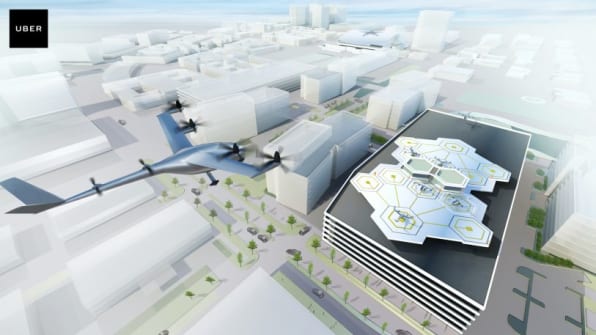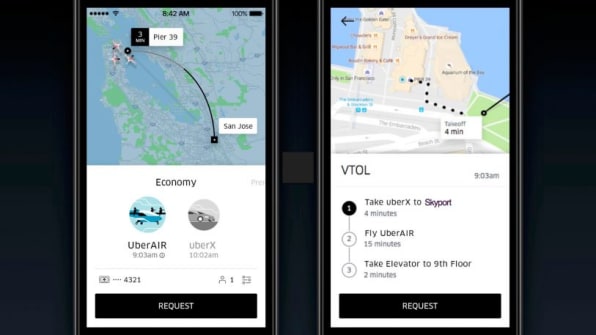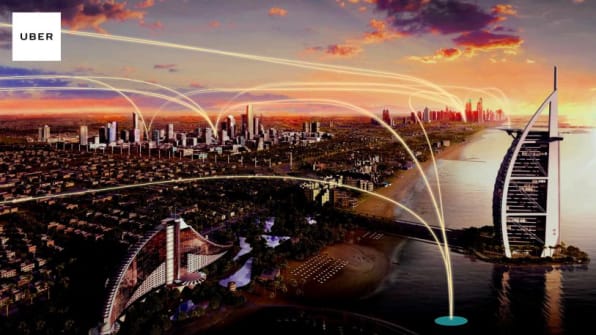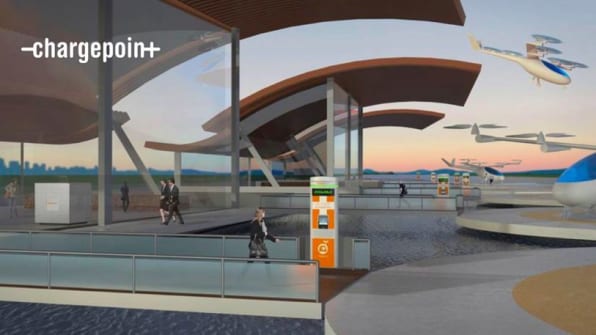Uber’s Flying Taxis Will First Take To The Skies In Dallas-Fort Worth And Dubai
Look, up in the sky. It’s…a taxi! That could become reality in six to 10 years if Uber fulfills its vision of a flying cab system. Ahead of its Uber Elevate Summit in Dallas today, the ride-hailing giant shared exclusively with Fast Company its plans for urban air travel—expanding on ideas included in a white paper published last year. They include the choice of cities to start testing the technology and the initial lineup of five aircraft makers it will task with building economical, four-passenger, electric craft that will—eventually—fly themselves. (Uber is live-streaming the three-day conference from the Elevate Summit home page.)
Whether they are helicopters, quad copters, or space-age airplanes, all the craft will have to be capable of vertical takeoff and landing, called VTOL, in order to fit into mini-airports, known as vertiports, spread around cities. And they will have to be quiet enough to take off and land near homes and offices without driving people crazy.

Convincing Cities
That last challenge could be the greatest one of all—at least in the U.S., where a hodgepodge of local, state, and federal agencies all have to get on board and convince the public that the technology is safe and not too intrusive. In Dubai, it should be easier to get it started. “It’s a monarchy, so they have the ability to move very quickly with things that they get behind strategically,” says Jeff Holden, Uber’s chief product officer. “The certification of machinery and the approach to getting the aircraft through could be a much faster path [than in the U.S.].”
In fact, Dubai has already green-lit a program by Chinese drone maker EHang (unconnected to Uber) that will start sky taxi flights in July. Dubai hopes to have at least a demonstration Uber vehicle ready to show off in three years when it hosts the 2020 World Expo. “We’re still not exactly positive what we’ll deploy there,” says Holden. “It could be a simple demonstrator; it could be something further along.”
In the U.S., Uber has won over the mayors of both Dallas and Fort Worth. “Every part of this marketplace, we’re seeing tremendous growth, says Dallas Mayor Michael S. Rawlings. “So it’s going to need innovative transportation answers.” Dallas-Fort Worth is one of the largest urban areas in the U.S., and it’s also an airplane-friendly town. “We have a history of aviation,” says Rawlings. “We have American Airlines, Southwest, Bell Helicopter, so many.”
Uber has pitched Elevate as a cheap alternative to building new roads and expanding public transit. But Rawlings isn’t buying that, saying Dallas has to be “multi-modal,” with many ways to get around. He touts the construction of a high-speed rail link to Houston, for instance. “Anytime there’s innovation in the marketplace, I don’t think anybody truly knows the results of these things, or the costs,” he says. “We’ve got to be multimodal—there’s no question—in this city.”

Uber is also tackling the big challenge of finding places to take off and land. “To make [an air taxi business] happen is going to require infrastructure, because it doesn’t make sense to take a 15-minute flight if you have to drive a half hour out of town to get to the nearest airport,” says Yolanka Wulff, executive director of the CAFE (Comparative Aircraft Flight Efficiency) Foundation. (Neither Wulff nor CAFE are associated with Uber.) Today Uber also announced a deal with Hillwood real estate in Dallas. Hillwood founder and Dallas native Ross Perot, Jr. is an aviation fan. In 1982, he made the first helicopter flight around the world. He also served as an Air Force pilot for over eight years. (Uber says it’s working on deals with real estate companies in Dubai, too.)
The likely plan in all cities is to locate vertiports on top of buildings. “It’s anything from residential structures to office structures that have roof space they can use,” says Holden, “or structures they can build or add onto.” Uber’s concept illustration for Dallas shows a plane landing atop a parking garage, but Holden says there might be vertiports on the ground, too. Rawlings is receptive, noting that Dallas already accommodates a lot of airports. “I think we’ve been able to negotiate that very well,” he says. “There are issues, and we’ll just have to deal with those issues as they arise.”

ideally in walking distance. [Image: courtesy of Uber]
Air Taxi Makers Announced
Given Uber’s demand for quiet VTOL aircraft, its first batch of manufacturers includes some unexpected choices. They include Dallas-based Bell Helicopter, military and civilian plane maker Aurora Flight Sciences, glider and small plane maker Pipistrel Aircraft, jet manufacturer Embraer, and private plane maker Mooney. Absent from the list are companies with craft that seem to perfectly fit Uber’s vision—even as portrayed in its conceptual drawings—such as Airbus (with its Vahana plane), Joby Aviation, and Lilium. All three have tilting wings or engines that point down for VTOL and then rotate parallel to the ground to fly like regular planes.
“Each of these partners that we’ve chosen brings something special to the table,” says Holden. “Bell has actually built these kind of aircraft before,” he says. “Embraer [has] done large-scale manufacturing, which is going to be a new thing that we introduce to the aviation industry as a result of Elevate.” Holden says that more companies may also join up. In fact both Airbus and Lilium will be speaking at Elevate.
The tilting wing or propeller design seems to be the favorite of Mark Moore, Uber’s director of aviation engineering, who joined the company in February after 32 years at NASA. Electric planes and tilt-wing craft were two of Moore’s main research projects before he left the agency. Helicopters seem to be inherently noisier and less energy-efficient (for reasons I explained in a previous story). Holden sounds more open to other designs. “We’re not telling any of the aircraft manufacturers, ‘You must build this design,’” he says.
Like A Private X-Prize
Uber’s Elevate program is a bit like an X-prize—competitions run by governments or nonprofits that push competitors to solve a bunch of really difficult challenges. (Pipistrel, in fact, won the NASA-CAFE Foundation 2011 Green Aviation Prize for energy efficiency, which was funded by Google.) But instead of teams competing for prize money, it’s companies competing for lucrative deals with Uber. (And with a near $ 70 billion valuation, Uber can throw lot of money behind projects.) In fact, not getting on Uber’s short list could be a huge disadvantage to aircraft makers, since that’s where the big money is.
“Right now there’s vehicle [makers] developing all sorts of different approaches,” says Mark Moore, “going in any direction because, frankly, we have these brand new…technologies in electric propulsion, in autonomy that let us design aircraft differently.”
Of the companies announced by Uber today, Aurora is probably the closest to Moore’s vision. Its LightningStrike design, funded by the U.S. government’s Defense Advanced Research Projects Agency (DARPA), will have 24 propellers encased under four wings that tilt from downward to rearward positions. LightningStrike is a military craft; but clearly Aurora thinks it can adapt the technology for other planes. Currently, the LightningStrike is just a model plane-size prototype, whereas Lilium just flew a full-scale plane with a similar design. Aurora also makes autonomous drones and helicopters for the military and an autonomous twin-engine civilian plane—key technologies for robo taxis.
It will be interesting to see how all of these companies tackle the noise problem. “My fear…is that there are hundreds of millions of dollars being invested in potential sky taxis whose noise signature will disqualify them from commercial use,” says Brien Seeley founder of the Sustainable Aviation Foundation, which is not affiliated with Uber.
“I think there’s more to be learned about how much noise, what it means, and how we’re going to work flight patterns,” says Mayor Rawlins. “So it’s probably premature for me to opine on that.”
The challenge will be most difficult for helicopters, whose giant, fast-spinning rotors send whooshing and rumbling sounds over a large area. But a bunch of buzzing little propellers—on planes like the LightningStrike—could also be awfully loud compared to traditional planes with just one or two bigger, slower-moving props. “If a company heavily invests in that kind of vehicle, and the other company brings out a fixed-wing [plane] with very slow, quiet-turning windmill, someone’s going to lose economically in a big way,” says Seeley.
Technology might improve vertical-takeoff craft, though, says Seeley, who has proposed an X-prize to develop an ultra-quiet plane (no louder, from 130 feet away, than the sound of nearby conversation.) “Its tendency is to be more noisy,” he says, of vertical-takeoff planes. “And yet, it offers so many advantages that if the noise demon can be slain in the small-rotor world, it’ll be the champion.”

Another big challenge will be developing electric planes with batteries that can last long enough for a few flights and charge up quickly for more time in the air. “It has to be in a small number of minutes,” says Holden. “If you’re sitting there for half an hour at the vertiport, it’s going to have a massive impact on throughput.” Uber has tapped ChargePoint, which makes rapid electric cars chargers, to develop plane-charging stations for its vertiports. Mark Moore is bullish about new technology. He points to Tesla’s national network of 842 supercharging stations, which can replenish its car batteries to 80% in a half hour. He’s optimistic that in half a dozen years, charging plane batteries up to 80% could take a little as three minutes.
Holden says that Uber aims to see planes (or copters) go into mass production in six years, with the goal of establishing large-scale service in about a decade. For that to happen, manufacturers will have to move fast. “To take an electric plane through the certification process is easily a five-year process right now,” says Yolanka Wulff. “And that only gets you to the point of being able to [start to] manufacture those planes.”
Not Your Typical Uber Driver
Uber’s ultimate goal is to have fleets of taxis that fly themselves. But given the challenge of getting self-driving cars on the roads, it could take even longer to get self-flying taxis in the sky. “Certification for autonomy will be a long process, simply because it hasn’t been done,” says Holden, adding that, “Software in general is not one of the areas where there’s an efficient certification path.”
Uber’s taxis will start service with fully certified commercial pilots, who may be the company’s first full-time drivers. Such aeronautics pros aren’t very cheap, however, or very common; and neither will the initial flights be. “I don’t think it will be a crazy premium,” says Holden. “I think it will be something that a lot of people will seriously consider, but it won’t start as an everyday [service].”
This is a familiar pattern for Uber, whose car service also started as a luxury offering, says Holden. But prices dropped as more cars got on the road and as riders were able to split costs using Uber Pool. (Billions of VC funding to subsidize rides have helped, too.) Uber is planning on taxis with room for four passengers, plus a pilot. “It’s very much like a car, and it works very well for pooling,” says Holden. The goal is to make using Uber—on land and in the air—cheaper than owing a car.
“This is kind of a vision right now,” says Mayor Rawlings, “so it’s hard for me to really commit exactly to what the benefits to everybody are, and to whom it’s a benefit. I’ll reserve the final pitch [to voters] until I understand it a little bit better.”
As soon as professional pilots take to the air, Uber will start refining the technology to replace them. “Our approach is to initially have piloted aircraft but run autonomy software in parallel,” says Holden. “And that way we can look at what the autonomy would have done in comparison to what the pilot actually did.”
Uber hopes the next phase will be to employ semi-autonomous planes driven by lightly trained pilots. “It’ll be more demanding than getting a driver’s license but far less demanding than getting a helicopter pilot’s license,” says Holden. You probably won’t see people doing it for just a few hours a week, as some Uber car drivers work.
This intermediate stage may not last long, as the end goal is to do away with pilots—although Uber isn’t predicting how soon planes will be able to fly themselves. In other words: Those pilots could someday experience the same anxiety and rage felt by Uber car drivers that they’ll eventually be replaced by robots.
(43)



